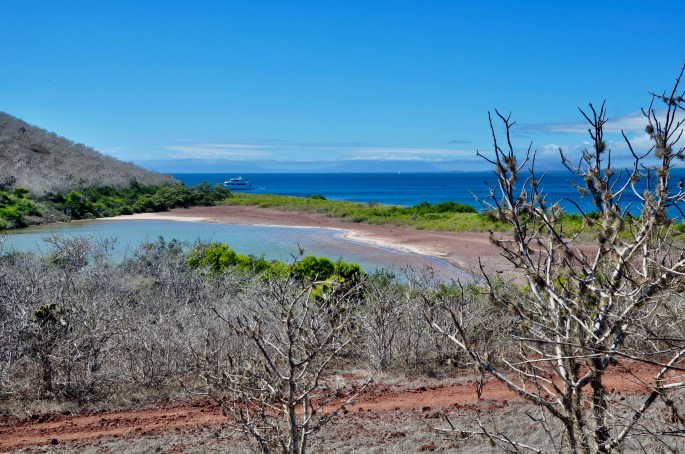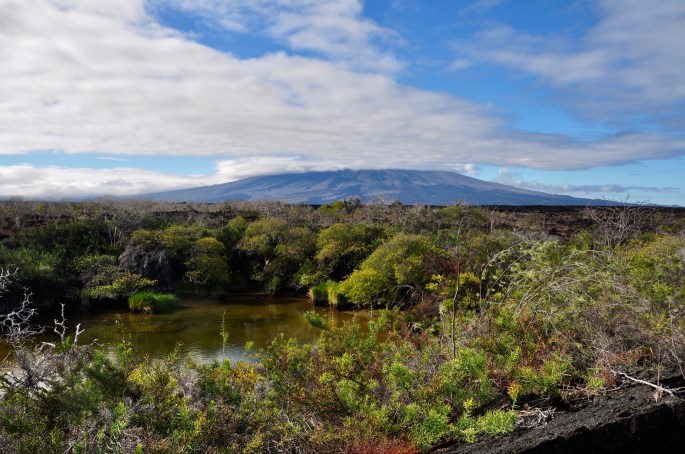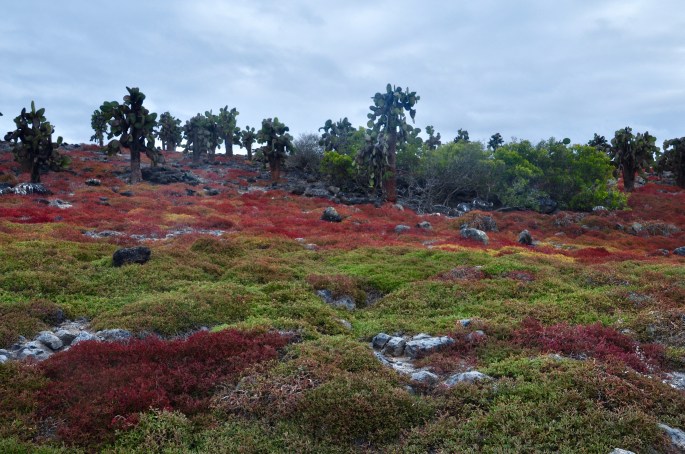Day 6: Tagus Cove, Isabela Island and Fernandina Island
We had breakfast a little earlier than usual so that we could be out on the zodiacs at 7am to see the sea birds when they are at their most active. We saw cormorants, pelicans & blue footed boobies along the rocks of Tagus Cove. We then pulled up to the staircase for our morning hike. Tagus Cove is really famous in the Galapagos because of the graffiti you can find there. People have etched the name of their boats and the year in the rock for hundreds of years. We saw the earliest engraving which was from the boat called Phoenix in 1836! Name carving has been banned since the 90s.
We started to walk up the hill and came to our first viewpoint of the spectacular Darwin lake. It is a beautiful turquoise salt lake sat next to the ocean but without any link to it. Though there wasn’t much in the way of wildlife, we both agreed it was our favourite landscape walk. The island was covered in white trees that made the most stark contrasts against the blue of Darwin lake. We stopped at 3 different viewpoints on our walk offering different perspectives of the lake whilst the final viewpoint at the top even let us see Wolf Volcano on another island! Back at the bottom, as we waited for the zodiacs, a huge pod of penguins swam past us! It was by far the most we had seen and I was so happy to be quick enough to snap a photograph which has over 16 penguins in one photo!
We came back to the boat for a quick wet suit change ready for our first snorkel of the day. Dave was ahead at the front of the group and said he chased the group of penguins only for them to change direction and swim right past him! I didn’t see the big group but I did have one rogue penguin swim straight into my goggles as I came round the corner of a rock! Unfortunately we didn’t capture either penguin encounter on the GoPro but it was a highlight for both of us! On this snorkel, we saw SO many starfish! There’s a few different types of starfish included a small yellow one with brown spots called the Chocolate Chip Starfish – seriously! Our guide also spotted a small Jackson shark resting on the ocean floor though he was quite far down and Dave and I are rubbish at free diving so we didn’t get to see it too clearly.
We got back on the boat for a short 40 minute navigation across to Fernandina island where we would have our second snorkel of the morning. This was our favourite snorkel so far because it was so diverse! For the first time, we saw marine iguanas diving under the water and munching on algae on the rocks. These incredible reptiles can hold their breath for up to 40 minutes! We saw 1 dive down, 3 eating underwater and 1 swimming along the surface towards us – it was so bizarre and absolutely amazing!
We swam further on and came in to a group of sea turtles where it was genuinely a struggle to swim around and not hit any of them! I’ve never seen anything like it, there were about 7 massive ones in a cluster! We both saw a flightless cormorant diving down underwater which was so fast but awesome. We then saw a penguin in the water, tried to follow him and then just round the corner, we found him sat on the rock right next to us whilst a sea lion played with us underwater! We managed to snap a photo with us and the penguin on the GoPro.
In the afternoon, we set off for our hike around Fernandina island. Fernandina island is the youngest of all the Galapagos islands and also the most untouched. It doesn’t have any introduced plant or animal species, so the island remains exactly as it was thousands of years ago. It is also a famous island because it is where BBC’s Blue Planet filmed the iconic snakes-chasing-baby-iguanas scene. Unfortunately that precise location is in a part of the island that tourists cannot visit, plus it wasn’t the right season. Having said that, I was so happy to spot a Racer snake snoozing in the shade in a crevice in the rocks! It was quite thin but really long – it had about 10 ‘bends’ where it lay and if you pulled it taut, so to speak, it would have been about 2 metres long!
The shores of Fernandina island have the highest concentration of marine iguanas. Everywhere you looked, there would be an iguana. There were so many that we even saw one with a Darwin finch perched upon it and one with a crab on top of it. These marine iguanas often spit too which is such a strange sight! They do it to exhale the salt water in their lungs from their dives in the ocean! They are so quick but Dave caught one spitting on film.
Fernandina island was special because we we got to see such diverse wildlife all seemingly sat side by side! A Galapagos hawk sat next to some chunky marine iguanas. Flightless cormorant birds next to the iguanas. Even sea turtles sunbathing in the shallows of the beach only half submerged with their shells poking out! I took one of my favourite photos from this trip where you can see marine iguanas, sea lions and sea turtles all in one spot!
We also saw an Oyster catcher bird who was protecting two eggs that it had laid so close to the path! There was no nest, just the eggs on the bare rock – something we had never seen before! The most fascinating animal however was the lizard on Fernandina island. We saw a larger lizard eating a small lizard!! Apparently when food is extremely scarce, the animals can resort to canabalism where the bigger ones prey on the small ones. I took a photograph and our guide, Fabian, even asked me to send it to him because in his whole life living in the Galapagos and then 10 years as a guide, he’d never seen it himself! Definitely my rarest and luckiest picture ever!
When we came back on board the yacht for the evening, we were all very excited when the Captain sounded the alarm to let us know there was a whale nearby. We only saw a brief spurt and its’ back so we don’t even know what type of whale it was but it was still awesome!
Thanks for reading and join us for the next day of the Galapagos cruise!
Sophie & Dave

Engravings within Tagus Cove

Crab

Footpath leading up to Darwins Lake

Tagus Cove engravings

Tagus Cove ships engravings

Dave with Tagus Cove in the backdrop

Darwin Lake viewpoint

Us at Darwin Lake

Group photo at Darwin Lake

Walkway around Darwin Lake

So many penguins!

A Whale bone on Fernandina Island

Marine Iguana

Catcus plant

Marine Iguana family portrait

Racer snake

Marine Iguana sunbathing

Pelican in flight

Oyster catcher

A young sea lion pup

Colourful marine iguana

A Crab on top of the Marine Iguana

So many iguanas!

Turtle, Sea Lion and Iguanas

Turtle in the sand

Mountainous terrain

Lava lizard eating a lava lizard

Lava lizard cannibalism

Whale sighting

Dave with a frigate bird circling

Penguin selfie

Chocolate-chip star fish

Us Snorkelling

Turtle in the shallows

Birds eye view of a turtle and pufferfish

Pufferfish

Marine iguana diving

Marine iguana eating

Marine iguana munching on algae

Turtle popping up to breath

Friendly Sea Lion



































































































































































































































































